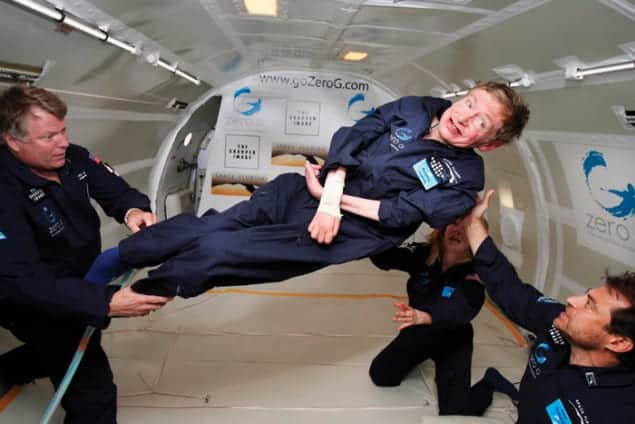My Brief History: a Memoir
Stephen Hawking
2013 Bantam Press £12.99hb 144pp
Hawking Incorporated: Stephen Hawking and the Anthropology of the Knowing Subject
Hélène Mialet
2012 University of Chicago Press $31.00pb 272pp

Stephen Hawking is famous for three reasons. The first is his reputation as a cosmologist. Back in the 1960s, when Hawking began studying singularities in black holes and the early universe, the field of general relativity was more or less in the doldrums. Hawking’s work helped change that, and he deserves a substantial part (though by no means all) of the credit for the field’s revival.
The second source of Hawking’s fame is his role as a science communicator. Some people are sniffy about his first popular book, A Brief History of Time, calling it “the least-read bestseller in history”, but I am not one of them. As a teenager, I lapped up every challenging word of it, and together with one of his later books, Black Holes and Baby Universes, it helped persuade me (and many other like-minded people) to study physics at university.
Like it or not, though, these achievements are overshadowed by the third component of Hawking’s fame: his public image as the stereotypical disabled genius. Cut off from most human interaction by the effects of motor neurone disease, which have rendered him almost immobile and unable to speak except through a computer, Hawking – so the story goes – chooses instead to concentrate on loftier matters. Even as his body remains confined to a wheelchair, his mind is free to journey to the furthest reaches of space and time.
In his memoir My Brief History, Hawking strikes a balance between scientific contributions, communication and image. Writing in his characteristic clear, concise style, he describes how, after an idyllic childhood and some rather lazy undergraduate years, his devastating diagnosis spurred him to make something of his life using whatever abilities remained to him. What follows are short sketches of his research career, interspersed with accounts of his travels, his two marriages and his role as an advocate for people with disabilities.
Readers with no previous knowledge of Hawking will find these stories interesting. For everyone else, though, the book will feel disappointingly superficial, and perhaps also strangely familiar (more on that later). The tales from his childhood are pleasant enough, but unlike the biologist Edward O Wilson, whose memoir Letters to a Young Scientist seems sure to become a classic, Hawking mostly declines to draw the sort of connections to his later career that would give weight to these reminisces. There are also some curious inclusions, and one even more curious absence. Hawking devotes nearly a whole paragraph to the Roman heritage of St Albans, his boyhood home, but nary a word to Jacob Bekenstein, whose ideas about black holes and entropy helped precipitate some of Hawking’s best work.
My Brief History is not entirely colourless, though. It does contain some moments of waspish humour, as when Hawking relates how his doctor told his then wife that he was coming home to die (“I have since changed my doctor,” he adds drily). Less pleasant are the book’s occasional brushes with sexism, as when he quips that “scientists and prostitutes get paid for doing what they enjoy” or grouses that the title of the television series The Ascent of Man would “not be allowed today” because it is not politically correct. And there is real heat in his gibes at particle physicists (“falling over themselves to latch on to the latest idea”) and his repeated digs at the widely held view that theoretical physics can only progress with the help of experimental data.
For insights on Hawking the man, and especially Hawking the scientist, you would be much better off reading Hélène Mialet’s book Hawking Incorporated. Mialet is an anthropologist, and her book is a densely-written “ethnographic study” of Hawking and the network of people and technologies that assist him. The existence of such a network, Mialet observes, is at odds with Hawking’s public image, an entity she calls HAWKING. How, she asks, has “this man who cannot move a finger without his nurse’s help…come to represent the mythical figure of the lone genius who can grasp the ultimate laws of the universe with nothing more than the strength of his reasoning”?
To find out, Mialet interviewed a dozen or so people, including her subject’s nurses, personal assistants and students as well as several of his colleagues. These are the people who enable Hawking not only to travel and give talks, but also to do the research and writing for which he is famous. Mialet refers to them as Hawking’s “extended body” and she reveals, in painstaking detail, how they transform Stephen Hawking – a 71-year-old man with a debilitating illness – into HAWKING, the world’s most famous physicist.
In his memoir (which came out after Mialet’s book was completed), Hawking writes that he is glad he became a theorist, because his disabilities would have prevented him from succeeding in experiment. Even so, his illness has profoundly affected the way he works. Hawking alludes to this briefly when he writes that he thinks in pictorial terms instead of equations “partly because it is difficult for me to write them [equations] down”. But Mialet, characteristically, probes deeper. For most people, she observes, doing mathematics is a very tactile process, and “one needs not only a head but also 10 fingers to write equations, draw diagrams and use a computer”. Moreover, “far from being a discipline in which one can devote oneself to the joys of solitary thought, theoretical physics requires intense collaborative work”. But Hawking cannot do any of these things easily, and some he cannot do at all. How has he managed it?
The answer, in a nutshell, is through his students. Because communication is so difficult for Hawking, his students learn to present their questions to him in such a way that he can give them maximum information with minimum effort. They also learn to translate his tiniest facial gestures and most cryptic comments into useful feedback. But this is an art, not a science. Although his students insist to Mialet that Hawking does help them, they often struggle to explain how. One is left with the impression that Hawking, even more than most senior scientists, relies on his students to do the intellectual grunt work.
More unsettling is the chapter on how the media and Hawking have collaborated to create HAWKING. In his public utterances, Hawking has repeated most anecdotes about himself many times; his assistants even keep an archive so he can call up previous comments as required. When he does this in interviews, journalists dutifully repeat his answers, treating each as a new revelation. But on the rare occasions when he deviates from the “script” – by, for example, expressing opposition to the Iraq war – Mialet shows that he is often ignored. Hence, regardless of whether he “plays the game and lets the media exploit his writings, or rebels and intervenes in the construction of his own myth”, the result is much the same. The public gets the version of Hawking it expects, and maybe the version it deserves.
As an anthropologist, Mialet is interested in this process because each repetition helps to standardize HAWKING, the public image. As a reviewer, I am interested because it explains why Hawking’s memoir gave me such a sense of déjà vu. Hawking is hardly the only prominent figure to engage in “recycling”, and since he can only write a few words per minute, he has a better excuse than most. Even so, the extent of his repetition is annoying. Why should anyone buy Hawking’s memoir when some of the most interesting stories in it have already been published – sometimes nearly word for word – in A Brief History of Time, Black Holes and Baby Universes or even, for heaven’s sake, an interview he once gave to Playboy magazine? And does the identity he constructs by such recapitulation have anything in common with what Mialet calls “the real, unique Mr Hawking, the flesh-and-blood person”? These are good questions, but neither Hawking nor HAWKING seem prepared to answer them.



